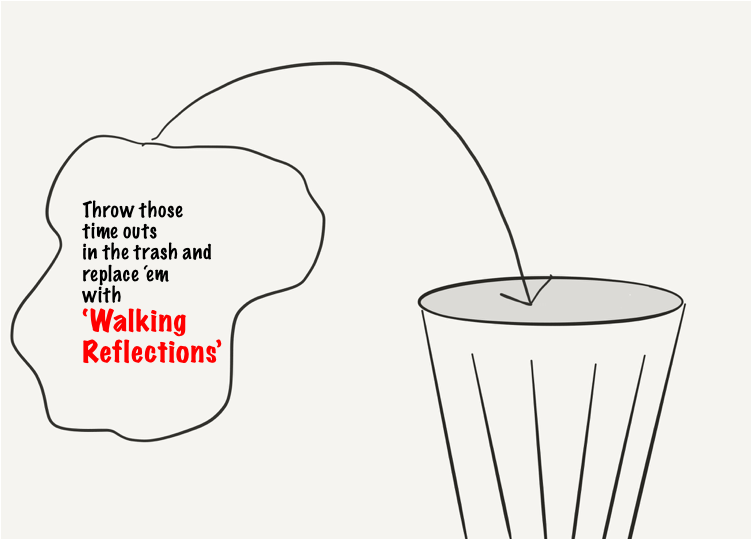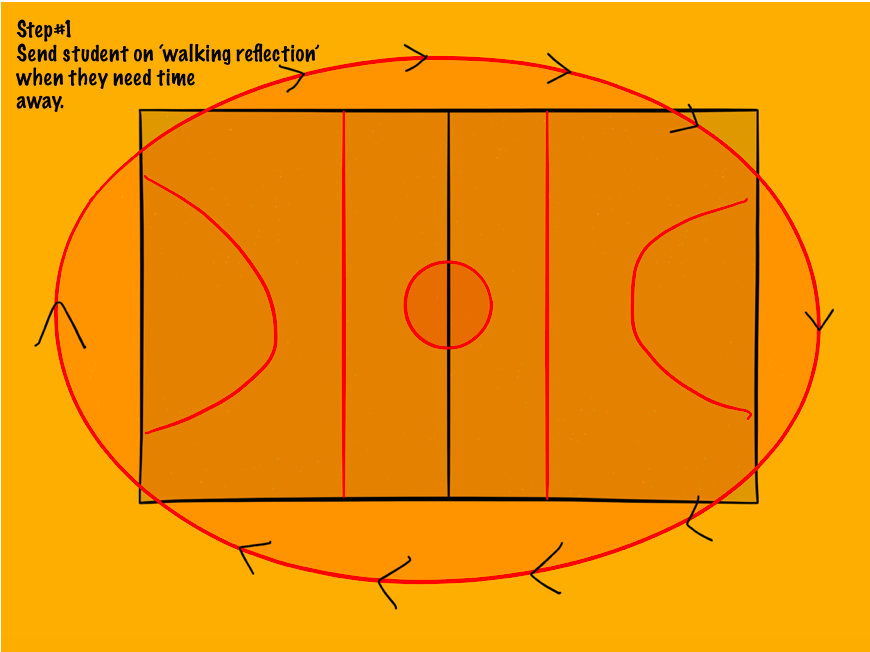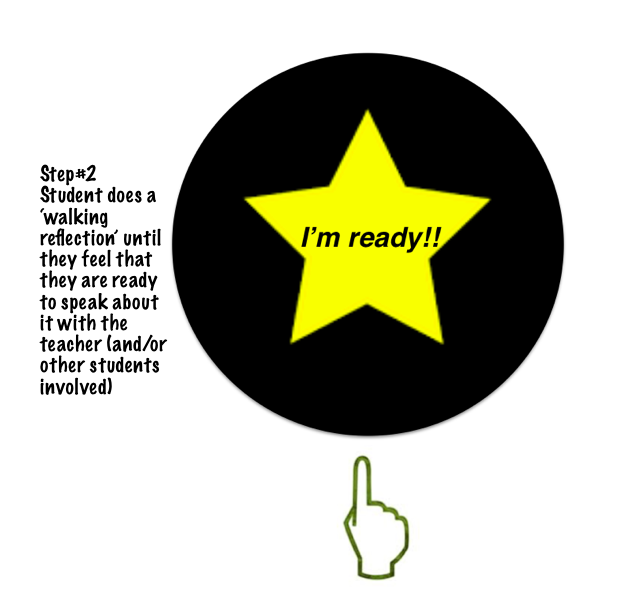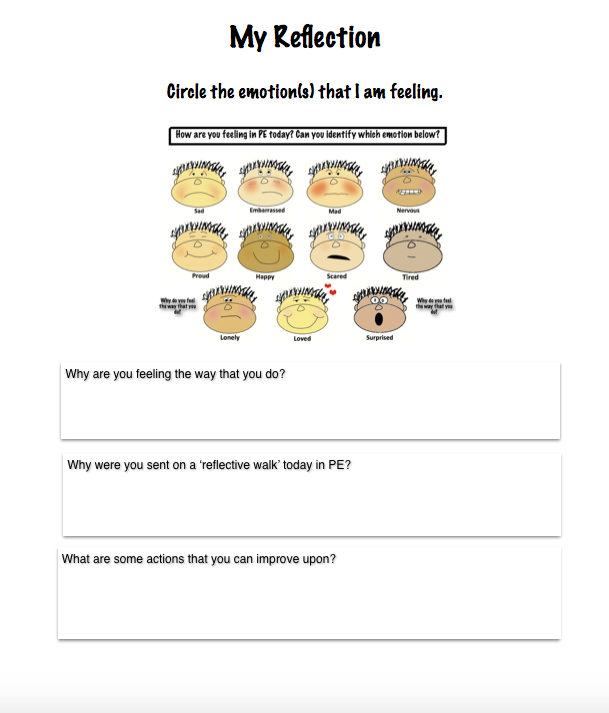|
I began to tinker around with 'walking reflections' last year in my classes. Rather than the traditional time out in which I tell the students to "Go and sit on the bench and think about things", I decided to try out something different. The 'walking reflection' strategy is an extension of my 'walk & talk' strategy. I've blogged about my 'Walk & Talk' strategy in the past and presented this idea several times at workshops and conferences in Asia, Europe, Australia and North America. I've received very positive feedback from teachers who have tried the approach out saying that it has worked well in their programs. As I am now in a consulting role, I often have a chance to observe a number of different PE programs in action. The general way in which poor behaviour is dealt with by teachers is by giving time outs and sending them over to a bench or some other area to sit. There is nothing wrong with this strategy as it is sometimes best to send students out when they get too worked up or behave poorly. However, I'd like to share with you a different approach that worked well for me when I put it into action last year. I call it a 'Walking Reflection' and the main idea is that it allows students to go for a walk around the gym or outside PE area to cool off and think about their actions. I find that allowing the students to be in motion while reflecting serves to help them cool down faster. There are a few steps that I follow when giving a 'walking reflection' to a student. This is how is goes..... Before going into step 1, it is important to clarify that most students will have received a warning first before having to do a 'walking reflection'. If there is a particular student who is really struggling or the behaviour exceptionally poor, no warning is given and they must immediately go on a 'walking reflection'. Step #1 When I notice that a student has misbehaved, I call them over and let them know that they need to go on a 'walking reflection'. This means that they must immediately begin walking around the gym and think about their actions. At times, it may be a problem between two or three students or it could be one student on their own. If more than one student is involved in the problem, they must do their 'walking reflection' separate from one another. Step #2 Students who have been given a 'walking reflection' continue to walk and reflect until they feel that they are ready to talk about it. I had a sign on my gym wall which indicated that that was where they were to go when they were ready to speak with me about the problem. The black circle with yellow star is just one example of what this sign may look like. In my program, the sign was about 18 inches (45cm) in diameter. It doesn't matter what the sign is provided that the students know that is where they are to go when they are ready to talk. As the students do their 'walking reflection', when they feel that they are ready, they walk over and stand under the sign which indicates to me that they want to speak about things. This kickstarts step 3 of the process. Step #3 If more than one student was involved, they have to both be under the sign which means that they are both ready to speak. Often times, what happens is that one student is at the sign first, standing there alone. They need to wait until the other student joins them under the sign to begin talking the problem out. When I see that the student or students are under the sign, I go over and have a discussion with them about what happened. There are times when I don't even have to get involved in the discussion if more than one student is involved because they work it out on their own. The chats never take that long and most of the time, the student or students are allowed to join back into class. Major Considerations I had just begun to use this approach last year and it really did work well in my program. However, there were times when some students would not be willing to go and stand under the sign to show that they were ready. When this happened, which wasn't that often, I would go over and join the student on the walk and begin to chat with them. We were usually able to resolve the problem and carried on with class. In some cases, there were a handful of students who didn't like to talk even though they were standing under the sign. When this happened, I had a reflection sheet ready to go and told them that they had to do a written reflection. Here is an example of what that written reflection template looked like: I've included a PDF copy of the reflection sheet for any teacher wanting to try it out. Click on the link below to download a copy.
The reflection sheet above is just one example. There are a number of different ways that you can design these reflection sheets. I thought that the positive emotions were a good thing to use on the reflection sheet as the students may express being 'proud' for having resolved the conflict or 'happy' that they made up with a friend, etc. The negative emotions on the reflection sheet gives them a chance to identify with the feelings they had when they were sent on the 'walking reflection'.
I have shared the 'walking reflections' with a few schools that I have consulted with in hopes that it provides teachers with different approaches to use when dealing with poor behaviour in their PE classes. I'm sure many of you are totally on top of behaviour management in your classes, but thought it was a good idea to share the 'walking reflection' strategy with you in case you want to try out something new. If you do try it out, let me know how it goes!
8 Comments
Lisa
3/2/2016 03:49:54 am
I really like this idea. I frequently send kids that are too angry to talk to go get a drink and walk a bit. It really helps them to chill out a bit first. I like the idea of having a spot for students to go to that need to talk to me... it would be great if they could just go there without the walking reflection if they felt they had something important we needed to talk about. Thanks.
Reply
Shelly Thibodaux
3/2/2016 09:52:32 pm
I set up walking cones on the hallway. Doors are open, they are supervised, walk one by one or I let them participate in the activity but with the person they are acting out with. This way they get to participate and only distract their partner.
Reply
Ashley
3/7/2016 08:01:13 am
I love this idea! Could you share more on what may happen if students got physical with one another? Is it practical to have them walking and possibly catch up to one another and fights continue? How do you handle situations when the students just want to argue with one another at the "I'm Ready" area instead of solving the problem?
Reply
Mary
3/24/2016 12:12:43 pm
Ashley: if S still angry to fight, then this is not for them, or they shouldn't stop at the "I'm ready" sign. I have a google form "stop & rethink" that S fill out. Gloria, Students with Autism may not be able to grasp it. Talk to Educational Assistants to help you individually plan for that S. One of my S with Autism needs to know he is being heard, it would work for him. Also S with Autism like social stories, help them anticipate the resolution in a positive way. Other S with DD follow first then activity, or short commands like Stop. All the best fellow PE friends-- after a challenging week, we need to reflect and think of how to do it differently. Usually I begin looking at what happened before the event that could have triggered it. @MrsNeal0
Reply
Gloria
3/9/2016 06:20:10 am
What about Special Education Students? I have a few Autistic students.
Reply
Allison
3/16/2016 06:04:02 am
Were the students you were trying to teach (presenting a unit or skill) ever distracted by the student that was taking "A Walk"? If so how did you deal with this? What grade levels do you suggest using this technique with? I like this idea, but I've talked to some teachers that have tried it and said it was too distracting.
Reply
jeff
6/8/2016 02:12:42 pm
What grade levels do you use this strategy with, and how do you use it when you go outside? Do you use this strategy if a student is talking when you are talking? What happens if a student walks for 10 seconds and then goes to the waiting place? And, how long do they wait for you to come over? Do you also use time out or does this take the place of it?
Reply
Leave a Reply. |
AuthorKAUST Faculty, Pedagogical Coach. Presenter & Workshop Leader.IB Educator. #RunYourLife podcast host. Archives
September 2022
|
||||||
- Welcome
- All Things Teaching and Learning
- The Aligned Leader Blog
- Consulting and Coaching Opportunities
- My TED X Talk
- My Leadership Blog
- Run Your Life Podcast Series
- How PYP PE with Andy Has Helped Others
- Good Teaching is L.I.F.E
- The Sportfolio
- Example Assessment Tasks
- PYP Attitude Posters (printable)
- Publications




 RSS Feed
RSS Feed
